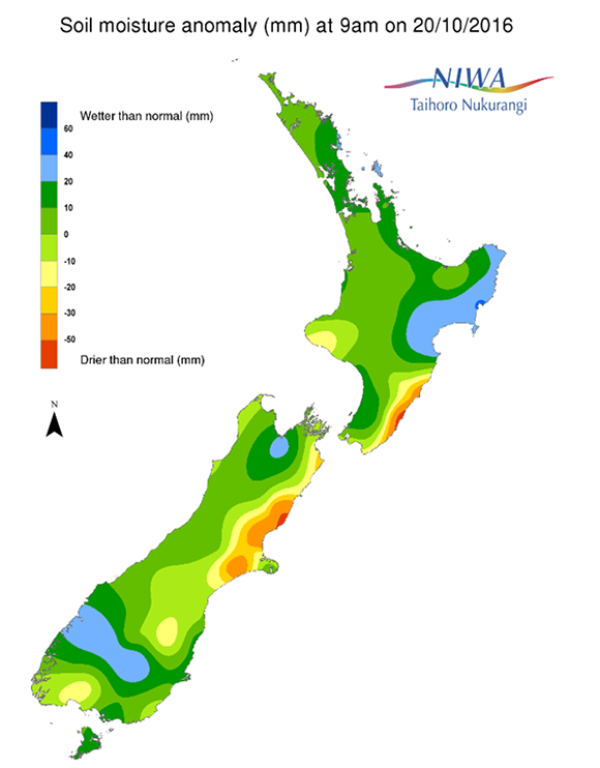For Thursday, 20 October 2016
A weekly update describing soil moisture across the country to help assess whether severely to extremely dry conditions are occurring or imminent. Regions experiencing these soil moisture deficits are deemed “hotspots”. Persistent hotspot regions have the potential to develop into drought.
Facts: Soil Moisture
Across the North Island, soil moisture levels are near normal for most locations for this time of the year, with wetter than normal soils for this time of the year for most of the Gisborne and Hawke’s Bay regions. However, soils are slightly drier than normal for this time of the year in southern Taranaki. The driest soils compared to normal for this time of the year are found in far eastern portions of Wairarapa and Tararua.
Across the South Island, soil moisture levels are near normal or wetter than normal for this time of the year for much of the northern, western, and southern portions of the island with the wettest soils for this time of year in and around the Nelson region as well as from northern Fiordland to Central Otago. Soils are slightly drier than normal in southwestern Southland as well as southwest Canterbury. From mid-Canterbury to far eastern Marlborough soil moisture levels are much drier than normal for this time of year. The driest soils compared to normal for this time of the year are found in coastal areas north of Timaru, especially in eastern Selwyn, Waimakariri, and Hurunui districts.
Note that the driest portions of both islands mentioned above have been dry for a long period of time, dating back to at least last summer.
Outlook and soil moisture
For the North Island, weak low pressure will bring generally 10 mm or less of rain to most locations on Friday and Saturday morning. However, Auckland and Northland will only see minimal rain from this event. Meanwhile, an easterly flow will enhance the rainfall across Gisborne and northern Hawke’s Bay, where amounts of 25 to 40 mm will be common. The interior ranges of these regions may see isolated rainfall amounts as high as 75 mm through Saturday night. Sunday and Monday will be primarily dry as high pressure takes control. More showers will arrive on Tuesday, bringing 10 to 15 mm of rain to most locations. A few showers may continue across the western and northern North Island into Wednesday, but these would only produce a couple millimetres of additional rain.
While official hotspot areas are unlikely to develop across the North Island during the next week, little relief is anticipated for the dry eastern Wairarapa region. Rainfall in the next seven days is unlikely to be enough to reverse the trend, and thus soils in this area will likely become drier. However, there may be slight improvement in the dry portion of southern Taranaki during the next week.
For the South Island, a southerly wind flow will bring beneficial rain to the eastern side of the island today through Friday morning, with amounts of 15 to 20 mm possible. Lighter amounts of 5 to 10 mm will fall in the rest of the island. Dry weather is likely across the entire South Island during the weekend as high pressure sits overhead. However, the next storm will deliver heavy rain to the West Coast on Monday and Tuesday morning, with many locations picking up 25 to 50 mm. As this storm moves farther east on Tuesday and Wednesday the eastern South Island may receive light rainfall, but likely less than 5 mm.
Rainfall in the eastern South Island over the next week will likely prevent dry regions of eastern and northern Canterbury from getting worse, and slight improvement may even occur. However, soils in far eastern Marlborough may become a bit drier in the next week, although an official hotspot is unlikely to occur.
Background:
Hotspot Watch: a weekly advisory service for New Zealand media. It provides soil moisture and precipitation measurements around the country to help assess whether extremely dry conditions are imminent.
Soil moisture deficit: the amount of water needed to bring the soil moisture content back to field capacity, which is the maximum amount of water the soil can hold.
Soil moisture anomaly: the difference between the historical normal soil moisture deficit (or surplus) for a given time of year and actual soil moisture deficits.
Definitions: “Extremely” and “severely” dry soils are based on a combination of the current soil moisture status and the difference from normal soil moisture (see soil moisture maps).

